Elizabeth Bridge
Elizabeth Bridge was named after Queen Elizabeth, the spouse of Francis Joseph I assassinated in Geneva in 1898. With only one 290-meter span stretching over the Danube, the original bridge built in eclectic style was known as the longest suspension bridge of the world.
 Empress Elizabeth (1837-1898) |
The international design competition for its construction was launched 1894 together with that of the present Liberty Bridge (originally called the Franz Joseph Bridge). In total, there were 74 design concepts coming in for the two bridges, 53 of which concerned the Elizabeth Bridge. Among the 74 applicants there were 15 Hungarians, even more Americans (16), some Italian, Austrian, German and French engineers as well as one participant each from Belgium, the Netherlands, Russia and Algeria. The prize-winning plans were submitted by German engineer Julius Kübler and his architect colleagues Eisenlohr and Weigle. However, their draft for a suspension bridge could not be realized from Hungarian materials. For this reason, new plans had to be developed, on the basis of which the Elizabeth Bridge became a three-span chain bridge.
The construction of the bridge was started in 1897 to the plans of Aurél Czekelius and Antal Kherndl. At that time, it was considered a most up-to-date solution to place the pillars supporting the portal of the bridge onto the river bank instead of the river bed. Thus the middle span of the bridge amounted to 290 meters, making the old Elizabeth Bridge the public bridge with the largest span in the world for 23 years.
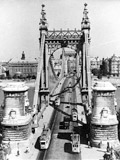 17-meter tall socle-like stone buildings |
At the beginning of 1902, construction works were disturbed by an unexpected incident: a 33-millimeter slip of the main-chain mountings was noticed at the Buda end. The installation was suspended until the complete investigation of the causes and the utilization of the necessary preventive measures. In order to prevent further slips, the abutments were propped by 17-meter tall socle-like stone buildings at both ends. Further support was provided by the installed cast iron weights as well as by gullet tooth-like basements enabling for the buildings to be attached to the riverside even more. Thus further slips could be prevented. In the course of investigations it had been found that the slips at the Buda end were provoked by the heating effect of Gellért Hill's thermal springs.
The bridge was inaugurated on 10 October 1903. The complete length of the bridge structure amounted to 378.6 meters, with the driveway being 11.0 meters wide, the pavements 3.5 meters each. The suspension bridge was ornamented with Art Nouveau elements. At the beginning, a wood brick road connected the rapidly developing Pest to the romantic Buda. Four lanes were available for public traffic, so that two rows of cars were able to proceed in each direction.
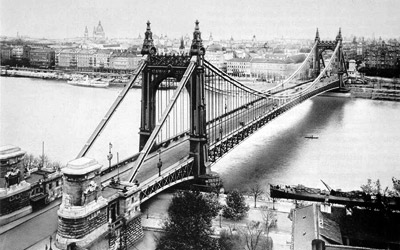
For 23 years, until 1926, the Elizabeth Bridge was the suspension bridge
with the largest span of the world
Initially, there was no public tramway line crossing the bridge, although its proportions would have enabled this. The first trams appeared on the bridge only on 14 August 1914, over 10 years after its inauguration. At that time, trams were essential to the traffic of Budapest. From 15 October 1928, there have been buses in service on the bridge, as well.
The wood brick pavement of the Elizabeth Bridge had been rather used up by the end of World War I so that its renovation became due. The work was hampered by the fact that there were no wood bricks available at that time so a decision was made to replace the wood bricks by a cobblestone pavement.
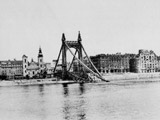 At the Pest side, the pylon and the riverside span were preserved |
Unfortunately, the Elizabeth Bridge, along with many other bridges, was blown up by German troops at the end of World War II, on 18 January 1945. Payloads were placed in the two chain-lockers of the Buda end. However, only the southern chain-locker exploded, the payloads in the northern chain-locker were found later, during the demolition of the bridge. Due to the explosion, the pylon contorted and was deformed to an unidentifiable mass by the chains. At the Pest side, the pylon and the riverside span were preserved and went on to be a sad spectacle in the view of Budapest. For quite a long time, no replacement could be built for the old Elizabeth Bridge.
Some period photos and spared parts of the original Elizabeth Bridge can be seen at the Transport Museum of Budapest in the City Park.
The new Elizabeth Bridge:
The Elizabeth Bridge is the only Danube bridge in Budapest that would not be rebuilt after the devastations of World War II. Instead, a completely new bridge was built between 1960 and 1964, nearly two decades after the destruction of the original Elizabeth Bridge.
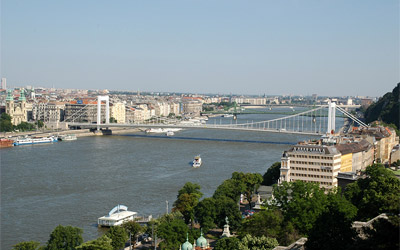
Pál Sávoly designed a new suspension bridge with modern lines
During the planning phase, the chain bridge vs. suspension bridge dilemma was brought up again. One side wanted the nice old bridge, others opted however for a new modern one saying that the original Elizabeth bridge was also quite up-to-date in its day. Finally, the latter idea was to be realized. Pál Sávoly designed a new suspension bridge with modern lines but also using the original pillars. As to the measures, the only difference between the old and the new bridge is that in the case of the new bridge, both pavements were added to the edges so that it is slightly wider than the old one. To commemorate the reconstruction of the bridge, two identical plaques have been placed at the southern part of the pillars in Pest and in Buda: "There has always been a favorable crossing-place here. From the 16th century on, there had been a boat-bridge. Later on, between 1898 and 1903 the Elizabeth Bridge, the fourth vehicular bridge of the new metropolis, Budapest was constructed here. This gem of the Hungarian bridge-building was blown up by the already defeated and pointlessly all-destroying fascists on 18 January 1945. The new Elizabeth Bridge had been constructed with three years' work and was completed in 1964. Preach this work the living will and the peaceful, creating labors of our people building the socialism."
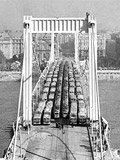 The public resistance test |
The public resistance test was a spectacular "dress rehearsal" for the bridge. 126 vehicles, buses loaded with sandbags, trams and lorries would drive up onto the bridge. The bridge was loaded with 2 000 metric tons, the sinking measured at the central part amounted to 90 centimeters. Evertyhing went according to plan. The rebuilt bridge was inaugurated on 21 November 1964. The length of its span - 290 meters - is identical to that of the old Elizabeth Bridge.
After the first stage of the underground line number 3 (M3) had been the completed in 1972, the tramway traffic on the bridge was suspended based on traffic studies. The removal of the tramway line and the reconstruction of the pavement were carried out in 1973.
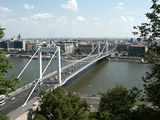 Most elegant bridge of Budapest |
Till this day, the Elizabeth Bridge is the most elegant bridge of Budapest, attracting the well-deserved attention of tourists due to its charming shape and snow-white color. The Március 15-e Square hosting the most ancient church of Budapest and the famous restaurant "Mátyás Pince" are situated at its Pest end. From here, the M3 station "Ferenciek tere" is no more than a five minutes' walk.
The Buda end of the bridge runs straight into the foot of Gellért Hill with the statue of St. Gellért who was thrown to his death from the hill by rebellious heathens in 1046. At the northern side, there is a nicely arranged park with a bronze statue of the eponym Queen Elizabeth. The baths Rác and Rudas are also to be found in this neighborhood.
|
||||||||||||||||
|
|
||||||||||||||
|
External links
- Mátyás Pince - One of the nicest cellar restaurants of Budapest
BRIDGES OF BUDAPEST
DID YOU KNOW?
Margaret Bridge was built to French plans. The iron elements forming the bridge structure were also manufactured in France.Read more


